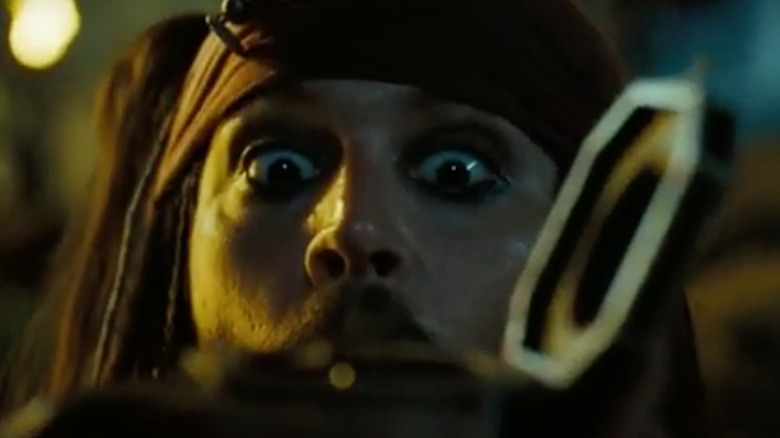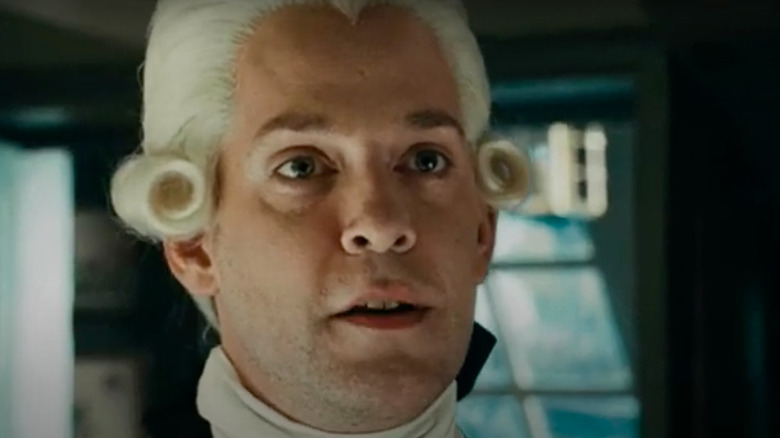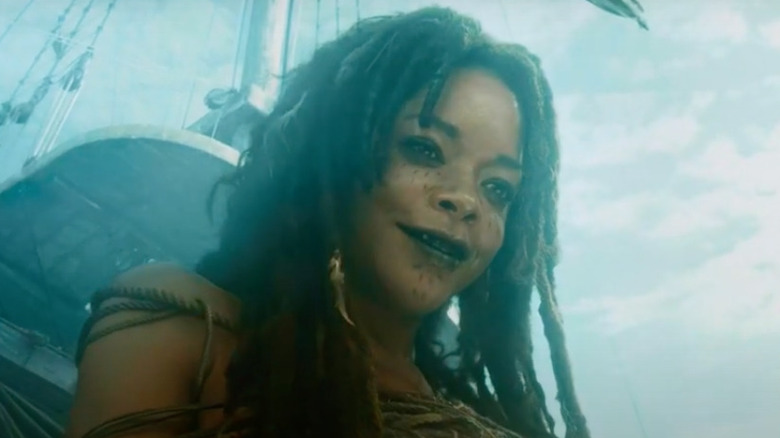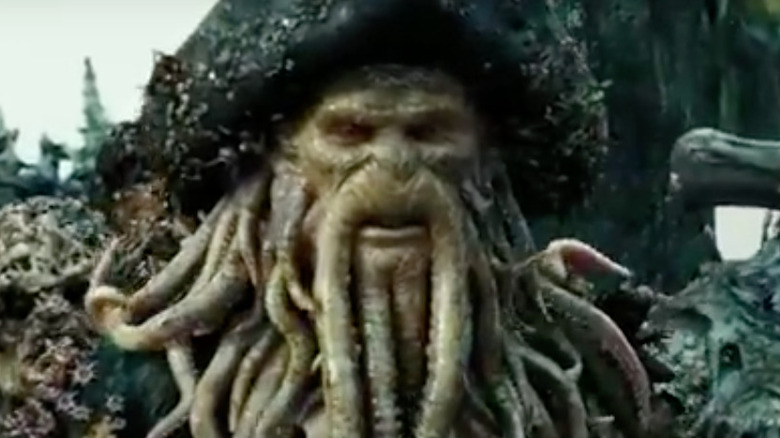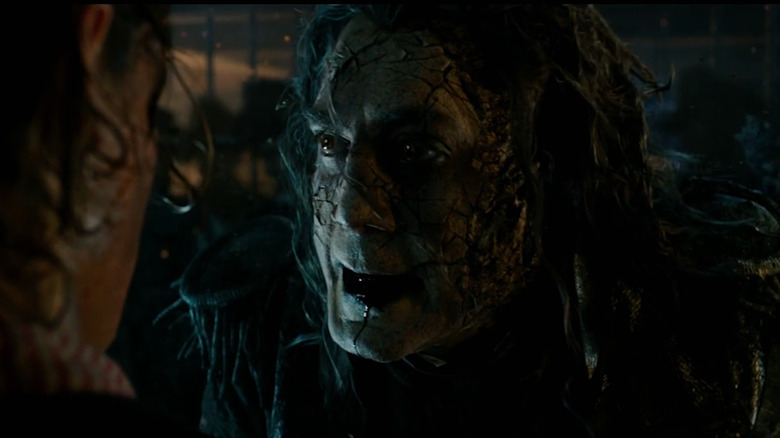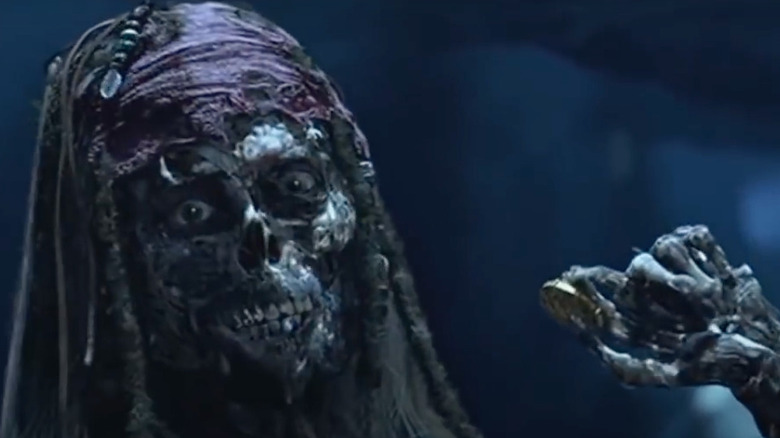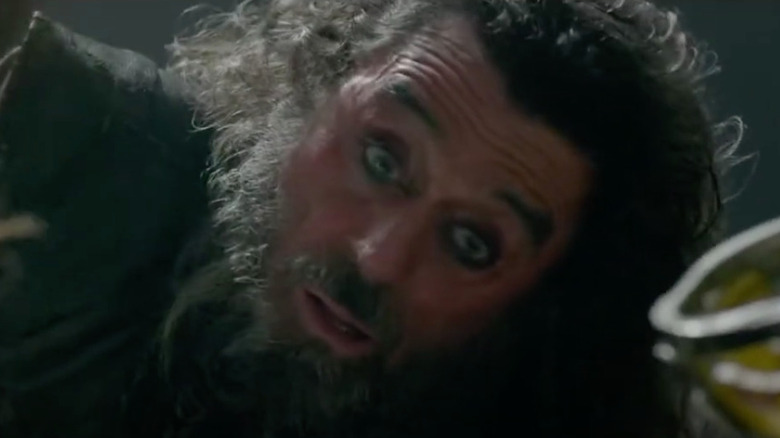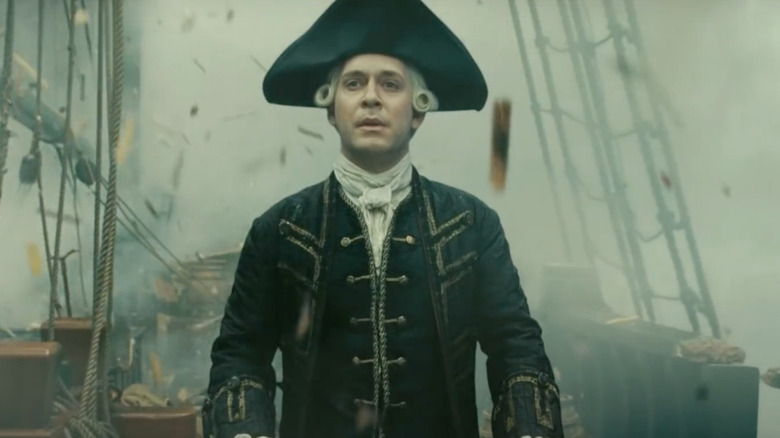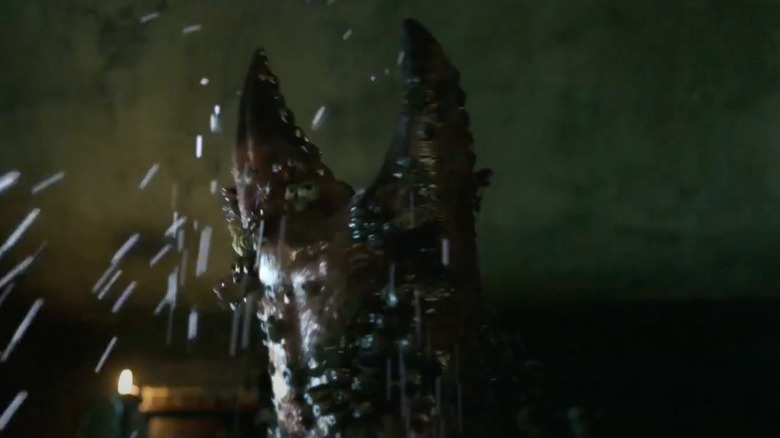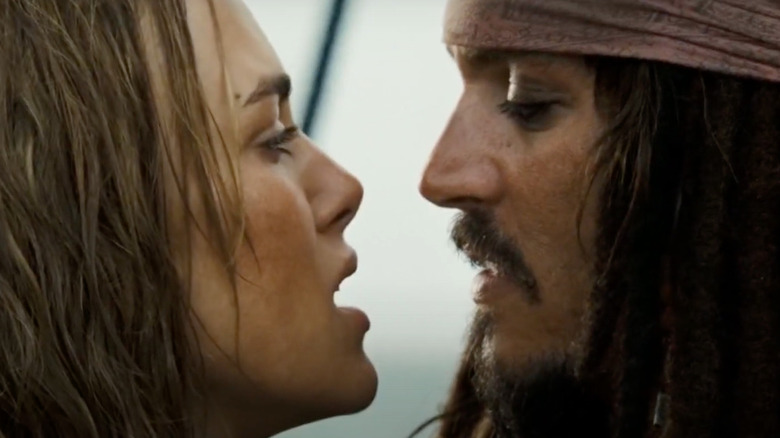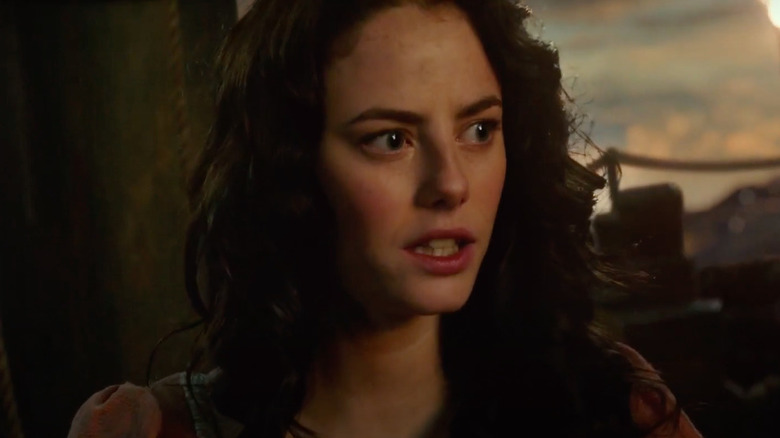Confusing Moments In The Pirates Of The Caribbean Movies Explained
We may receive a commission on purchases made from links.
One of the most popular film franchises of the 21st century, the "Pirates of the Caribbean" were unabashed popcorn blockbuster crowd-pleasers.
Starting with 2003's surprise "Curse of the Black Pearl," which singlehandedly reversed decades of "Pirates" and "Cutthroat Island"-fueled Hollywood skepticism that swashbuckling films would ever be popular again, moviegoers embraced roguish Jack Sparrow (Johnny Depp), evil Hector Barbossa (Geoffrey Rush), and young lovers Will Turner (Orlando Bloom) and Elizabeth Swann (Keira Knightley). The success of that film spawned four sequels, which collectively earned $4 billion at the worldwide box office. Unsurprisingly, it's considered one of the best pirate films ever made.
As the series progressed, however, the writers seemed to grow lazier in terms of connecting pre-established lore with newer storylines, often frustrating fans in the process. It can be hard to re-watch the films now, with some plot contrivances requiring long-winded explanations, others gigantic leaps in logic, and still more (perhaps) explainable via fan theories.
If you know such explanations, it can make the films substantially less frustrating. With this in mind, below are a list of the most confusing moments from the "Pirates" films, as well as the best attempts to explain what's going on. With any luck, this will make the films a bit more enjoyable for your re-watch. Full sail ahead!
Where did Jack get his compass?
When the audience first meets Jack Sparrow, he's in a rather pathetic state. He barely makes it to land before his dingy sinks, easily gets captured by Commodore Norrington (Jack Davenport), and carries few possessions on his person — notably, a compass that doesn't point north. As it turns out, this particular item isn't broken, but rather a mystical device that directs the user to what their heart most craves. The "Pirates" characters will subsequently use said compass as a means to find objectives, which is a convenient way for the writers to usher the plot from one development to the next.
There is some confusion in the films as to how Jack came upon this compass. In "Dead Man's Chest," Tia Dalma (Naomie Harris) notes that it was she who gave it to Jack after some bartering. Yet, in "Dead Men Tell No Tales," you can see Jack retrieving the item from the dying captain of the Wicked Wench when he was much younger.
While it's perfectly logical to accept this as a retcon, on behalf of writers who needed Jack to unknowingly free Salazar (Javier Bardem) from his mystical prison, a theory posted on Stack Exchange suggests Jack initially bartered the compass for his former captain.
"In other words," the post suggests. "The compass was only his after his Captain's death, when he actually inherited it."
Why does Beckett hate Jack?
"Dead Man's Chest" introduces Lord Cutler Beckett (Tom Hollander) to the "Pirates" franchise, and the villain wastes no time revealing his hatred for Jack Sparrow. Except, the film never clearly explains the long-running feud between the pair, leaving fans to fill in the gaps.
Those seeking a more clear-cut answer should check out a deleted/expanded scene in "At World's End," which explains the animosity that arose between Beckett and Jack. Apparently, Jack struck a deal with Beckett to deliver "cargo," but ended up liberating said cargo (i.e. people) instead. In retaliation for his disobedience, Beckett sunk the Black Pearl, leading Jack to make his deal with Davy Jones.
Now, in "Dead Man's Chest," Beckett tells Will Turner that both he and Jack left a mark on the other. We get a good look at the "P" — for "pirate" — branded into Jack, but never see how our hero marked the East India Trading Company's slimy leader. Instead, fans have to read the 2011 novel "Pirates of the Caribbean: The Price of Freedom" for further details. The story revolves around Jack's exploits with the East India Trading Company during his early years, in which he refused to reveal the location of a lost island, and set a ship full of slaves free. Jack more or less sullied Beckett's reputation, prohibiting him from ascending the ranks, leading to the rivalry we see in "Dead Man's Chest" and "At World's End."
Why did Tia Dalma become a giant?
Why did Tia Dalma (Naomie Harris) grow into a 50-foot monster at the end of "At World's End?" As viewers learned throughout the course of "Dead Man's Chest" and "At World's End," long ago, Tia Dalma (as Calypso) charged Davy Jones (Bill Nighy) with ferrying souls to the afterlife. During this time, the pair fell in love and the sea captain vowed to meet Calypso on land, following his ten years at sea. Jones did as promised, but when he returned to land Calypso didn't show up. This in turn prompted Jones to betray Calypso, who was subsequently bound to human form by the pirate lords.
Before rising to power (so to speak) during the climax of "At World's End," Calypso learned that it was Jones who betrayed her. Enraged, the sea goddess increased in size and shouted (in another language): "Across all the waters, find the path to he who wrongfully entombed me" before exploding into a flurry of sea crabs that leap into the sea.
One Reddit user seems to sum up the Tia Dalma storyline thusly: "She is released from her human form and returns to the sea. She's mad at the Brethren Court pirates for imprisoning her in human form, and at Davy Jones for showing them how. So she summons a maelstrom to wreak havoc on all parties equally. That's where her story ends."
Why does Davy Jones look like an octopus?
When Calypso charged Davy Jones with guiding souls to the afterlife, she promised to meet Jones on land every ten years; when the time came, however, Calypso failed to show up. Feeling betrayed, Jones gathered the Brethren Court and told them how to bind Calypso, resulting in her becoming the sorceress Tia Dalma.
Feeling guilty for his betrayal, Jones then cut out his heart and negated his responsibility as captain of the Flying Dutchman. As punishment for his failure to guide the dead to the afterlife, Jones was cursed. His beard transformed into tentacles, his hands into crab claws. Whether Calypso was responsible for this curse is uncertain, though, at one point in "At World's End," she touches Jones with her hand and instantly transforms him back to his human state.
According to writer Terry Rossio, on his site Wordplay, Jones' curse would have been lifted had Calypso followed through with her promise. "If the person Jones had been in love with had been true, and waited for him, and stayed in love with him for ten years, upon his return to land his curse would have been lifted. That's a big part of the reason why Jones is so bitter and cruel. He had a chance to lead a normal life ... but his lover was fickle."
Why doesn't Will die when his curse is lifted?
The entire plot of 2017's "Dead Men" involves Will's son Henry (Brenton Thwaites) searching for the trident of Poseidon as a means to free his father from the Flying Dutchman. The trident contains all the magical spells and curses of the ocean. One need only destroy the magical relic to release cursed individuals such as Will from their magical bonds. By film's end, our heroes accomplish their mission, Will reunites with Elizabeth and the world is as it should be.
Except, in 2007's "At World's End," Will's heart was removed from his body as part of the ritual necessary to bind him to the Flying Dutchman. So, in theory, if Poseidon's trident is destroyed, shouldn't Will drop dead on the spot, as a result of not having a heart inside his body?
There are a couple of interesting theories floating around the internet about this very plot point, but perhaps the best comes via TVTropes.com.
"Salazar's undead crew grew back body parts after the curse was lifted," the site speculates. "We can assume the same thing happened to Will."
Indeed, the finale of "Dead Men" sees the trident broken by Henry and Jack, thus returning mortality to Salazar's mates on the spot. So, it stands to reason that Will's heart magically regenerated itself inside him once the curse was lifted, resulting in his happily ever after. Let's just hope he was above water at the time.
Why didn't Salazar break free earlier?
Through a "Dead Men" backstory, the audience learns that Salazar (Javier Bardem) and his crew are bound to the Devil's Triangle via magical properties directly related to Jack's compass. In a moment of weakness, Jack inexplicably trades the compass for some rum and unknowingly frees Salazar from captivity. The biggest issue with this plot point is that Jack had time and again given his compass to other characters throughout the "Pirates" franchise. In "At World's End," he gives the device to Will, who uses it to find Beckett and Shipwreck Cove; and later, in "On Stranger Tides," Gibbs uses it to find the Black Pearl, and so on.
Technically, Salazar should have been freed long ago, right? Not so fast. According to YouTuber Bryce Edward Brown, Jack's intentions during the previous transactions were far different than his deal for rum. He did indeed give the compass to other people, but always with the intention of getting it back later. In other words, he didn't give the compass to Will, but allowed his friend to use it for a time. Similarly, Gibbs borrowed it to find the Pearl, but Jack never intended his crewmate to keep the compass forever. As such, fans can conclude that Jack never betrayed the compass until he literally traded it for booze in "Dead Men."
Why doesn't Jack die when the curse is lifted?
The first "Pirates" movie revolves around cursed treasure located on the Isla de Muerta. Apparently, Jack Sparrow and Hector Barbossa discovered the locale and took the gold for themselves, not knowing that doing so cursed them to live out their lives as zombies — unable to die, but prohibited from enjoying the pleasures of life. (Jack escapes this fate, via a series of unfortunate circumstances.)
This plot point comes to a head at the end of the film, when Jack and Barbossa square off near the cursed treasure. At one point, Barbossa stabs Jack, but since the hero snagged a piece of gold before the battle, his body is zombie-fied and the sword has no affect. Later, Jack shoots Barbossa moments before the curse is lifted (while he's still a zombie) and the bullet wound somehow kills the pirate captain the moment his corpse returns to a living state.
Why did Jack survive his wound while Barbossa died from his? Video editor/producer Matthew Belinkie, on the site Overthinking It, has a theory: "Zombie pirates have a 'healing factor,' a la Wolverine. You stab them or shoot them, and the wounds quickly disappear. However, if the curse is lifted before a wound heals, then the wound 'counts.'"
How does the Fountain of Youth work?
"On Stranger Tides" has plenty of seemingly contradictory plot points that threaten to leave viewers numb from confusion. One of the film's biggest head scratchers lies with the magical properties of the Fountain of Youth. What does this particular MacGuffin do, exactly? Per the film, the Fountain of Youth grants the user eternal life — but in order to utilize it, the user must locate two silver chalices and somehow obtain a mermaid's tear. Said tear must be dropped into one of the chalices (the other will only have water). Whoever drinks the cup with the tear will receive all the years of life from the person drinking the other cup. Simple, right?
Of course, problems arise when one starts to think about how Jack uses the Fountain to save Angelica (Penélope Cruz). In the film, both Angelica and her father Blackbeard (Ian McShane) are mortally wounded. In order to save the former, Jack tricks Blackbeard into drinking from the wrong chalice. Angelica is instantly healed and seemingly granted the remaining years of her father's life. But, wasn't Blackbeard dying at the time his daughter drank from the cup? Meaning, he has no years left to give? Shouldn't she drop dead on the spot?
There are a number of theories that attempt to explain this odd plot point; perhaps it is best to not overthink the hows and whys of its magic.
Why did Beckett give up?
In the finale of "At World's End," Jack Sparrow vanquishes Davy Jones and successfully transfers the villain's command of the Flying Dutchman over to Will Turner. Together, the pair turn their respective ships on Lord Cutler Beckett's own craft, the HMS Endeavour, and proceed to blast the vessel to bits. Meanwhile, Beckett seemingly freezes in his tracks at the sudden betrayal (he still thought Jack was on his side), to the point where he doesn't even issue commands to his men.
The Endeavour clearly packs more firepower — anywhere from 106 to 110 cannons total — and towers over the Black Pearl and the Flying Dutchman. Had Beckett given the order, it's likely the might of his ship would have ripped Jack and Will to shreds, or at the very least done a great deal of damage before sinking. Why didn't he fight until the bitter end, specifically with the entire East Indian fleet floating nearby?
One could chalk this up to the already bloated film needing to end at one point or another, but fan theories posit that Beckett was either in love with Elizabeth and knew that he could never have her now that Will was immortal, or in a state of shock similar to the captain of the Titanic and simply unable to function.
How did Davy Jones return at the end of Dead Men Tell No Tales?
At the end of "Dead Men," a post credit scene hints at the return of everyone's favorite barnacle-loving villain, Davy Jones. While fans will likely never see a follow up to this tease, the moment still ends the franchise on a curious note that left many viewers scratching their heads. You see, Davy Jones died during the climax of "At World's End," after Jack Sparrow stabbed his heart and sent him plummeting into a maelstrom created by Calypso. So, how is he suddenly alive again?
The "Dead Men'" plot revolves around the destruction of Poseidon's trident, a mythical artifact that (somehow) keeps every supernatural curse intact. By film's end, Jack and friends have successfully destroy the object, thus setting Will (and other cursed beings) free from their magical bonds.
One can assume the curse of Jones was lifted as well, but how did he come back from the dead? Well, according to the website PopCulture, "In 'Pirates of the Caribbean' mythology, Davy Jones isn't a cursed man like Will Turner was," and since Will's curse was lifted, he's no longer captain of the Flying Dutchman ... since the Dutchman is part of a natural order of life and death, there needs to be a captain, and with no cursed men left to do the job, that duty reverts back to its natural placeholder: the mythic figure known as Davy Jones."
Why did Elizabeth turn against Jack?
The "Pirates" films largely focus on good people who are tempted and ultimately thrust into the pirate life. Will rejects his swashbuckling roots only to end up as the captain of the Flying Dutchman; James Norrington rejects the pirate code and winds up as fish bait.
Elizabeth Swann likewise undergoes quite the transformation over the course of the first three films. At first glimpse in "Curse of the Black Pearl," she is little more than the spoiled daughter of Governor Swann (Jonathan Pryce), but by "At World's End" she has transformed into a full fledged pirate lord with her own ship and crew. Of course, Elizabeth doesn't go full pirate until the moment in "Dead Men's Chest" that sees her chain Jack to the Black Pearl, where he's eaten by the horrifying Kraken sea monster.
While many have questioned Elizabeth's sudden turn from amiable good guy to heartless turncoat, her actions make sense, because deep down she has always been a pirate. Also, she may even have loved Jack but, as theorized by Quora user Mia Richards, wanted him "to be the man to sacrifice himself for her and/or others." Clearly, that was never going to happen, which is why she leaves him to die, effectively forcing him to be the man she wanted him to be.
Why is Barbosa's daughter so young?
A big gaff in "Dead Men" apparently occurs when the audience learns that Carina Smyth (Kaya Scodelario) is actually Barbossa's long-lost daughter. Except, the revelation doesn't make much sense when one considers Carina's age.
Barbossa courted Carina's mother Margaret when he and Jack were still good friends, sailing the seas together aboard the Black Pearl. Per the "Pirates" timeline, the pair were last mates back in 1718, or the time Barbossa led a mutiny against Jack and took control of the Pearl. Since the events of "Dead Men Tell No Tales" occur around 1751, Carina should be over 30 — but the film leads us to believe she's actually 19.
To help explain the continuity error, TVTropes.com has a theory.
"Barbossa's relationship with Margaret could have been an on-and-off thing, with him being involved with her both when Jack was growing up among pirates and later on, after the events of the original trilogy," the site explains. "Sailors' romantic connections, then and now, have tended to be intermittent ones."
In other words, one can simply toss this plot hole in the unreliable narrator pile, as it is never explicitly stated when Carina was conceived. Barbossa could have returned to Margaret immediately following "At World's End," which is the only way Carina could have been born in the 1930s. Or, maybe she is really old and simply lies about her age.

